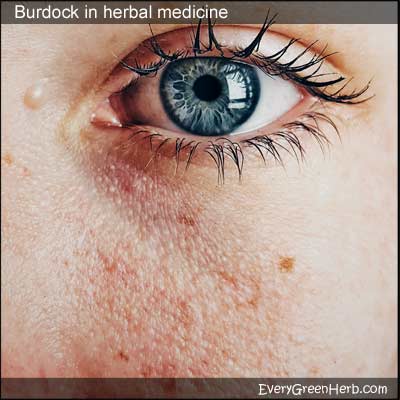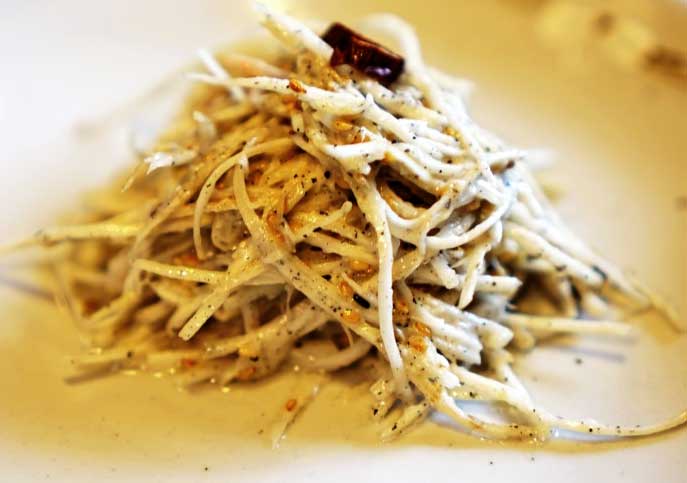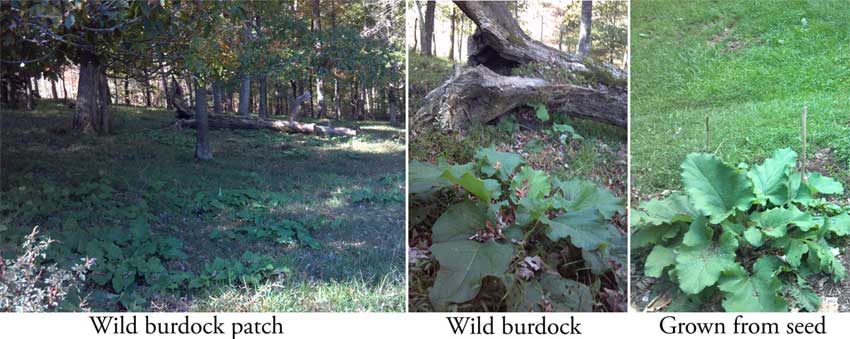Burdock in herbal medicine
Burdock (Arctium lappa) root has been used in herbal medicine for thousands of years. It is greatly valued for its skin healing properties and its liver cleansing abilities.
It purifies the blood, helps stop thinning hair, acts as a diuretic, and is useful in the treatment of mature skin.

Burdock root tea can help clear up eczema, dandruff, and scaly patches on the skin.
Burdock tea helps lots of common health problems.
Burdock root tea is a good choice when treating urinary problems, indigestion, and for cleansing the lymphatic system.
It can also be used to ease symptoms of sore throat and colds.
Burdock may be used in the treatment of cancer, AIDS, and chronic diseases like diabetes.
It is also good when treating acne, high blood pressure, and low sex drive.
Burdock tea tastes good which is another added benefit.
Burdock is good for the skin.
Burdock root is often combined with yellow dock and sarsaparilla for treating eczema. This combination makes an excellent home remedy for skin problems and scalp conditions.
The oily seeds are often used in skin tonics to promote smoothness and improve the appearance of wrinkles.
Burdock can ease joint pain.
It is used in the treatment of arthritis and joint pain.
The Asia Pacific League of Associates for Rheumatology conducted studies on burdock root that show it can significantly improve inflammatory stress in patients with knee osteoarthritis.
Burdock root has many beneficial anti-inflammatory, antioxidant, and antibacterial properties. Recent studies show that burdock contains phenolic acids, quercetin, and luteolin, which are all powerful antioxidants.
Burdock for good digestion
Burdock root contains insulin which feeds beneficial bacteria in the digestive system. Burdock also contains many minerals including chromium, copper, iron, and magnesium.
Burdock tea is easy to make.
To make burdock root tea, bring pieces of root to a boil, reduce heat, and simmer for five minutes. Enjoy plain or with lemon and honey.
Burdock poultice can help heal bruises.
Burdock leaves are used in poultices and compresses. Both are useful for natural treatments of bruises, burns, wounds, and gout.

Burdock as a vegetable
In Japan, burdock plants are used as food. Known as gobo, roots are eaten fresh or cooked. The young, tender leaves are cooked like any other vegetable green.
The stalks, which taste like asparagus, are eaten raw, boiled, or candied with sugar. Visit Korean Bapsang for an easy Braised Burdock Root recipe.
Interesting fact
Burdock fruits are also known as cockle burrs. These burrs led to the development of Velcro in the 1950’s.
Burdock plants
Burdock plants can grow up to eight feet tall although the average height is three to four feet. The root can reach depths of three feet making harvest difficult.
Burdock is considered a weed by many people but herbalists have long recognized its medicinal uses.
Herbalists have to dig deep to get burdock root out of the ground. Once harvested the root should be washed, dried, and stored for winter use.
My experience with burdock
I purchased dried, chopped burdock root at my local herb shop after reading that it was good for people with type A blood.
I made tea using a tablespoon of root pieces with two cups of water, boiling gently for a minute then steeping for five more minutes. The aroma was sweet and the taste was very pleasant.
After drinking a cup of burdock tea for a couple of days in a row, I noticed that my complexion was glowing. I was also able to get more exercise because my joints quit aching!
I completed so many chores that even Tony noticed and commented on it. Now since burdock is one of my favorite teas, I grow it in my herb garden.

We all need to try new vegetables, and do all we can to get fresh foods into our diets on a daily basis. Maybe burdock will catch on in more kitchens and perhaps even specialty restaurants will start serving it. I wouldn't be surprised.
*Pregnant or nursing women should avoid burdock. Avoid burdock if allergic to daisies, chrysanthemums, or ragweed. Do not take burdock if dehydrated. Diabetics should not take burdock as it could lower blood sugar levels. Do not mix burdock with blood thinning medications.
Always consult with your healthcare provider before taking any herbal remedy especially if pregnant, nursing, or taking other medications.
Sources:
https://pubmed.ncbi.nlm.nih.gov/20981575/
https://pubmed.ncbi.nlm.nih.gov/25350500/
Blessings to you and yours!
Thanks so much for reading my blog. Jan.

*Note - the information on this website has not been evaluated by the Food and Drug Administration.
© 2005-2024 website design and content by Janice Boling